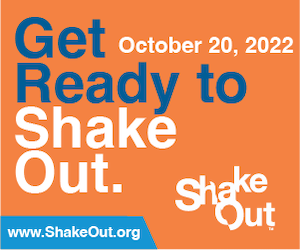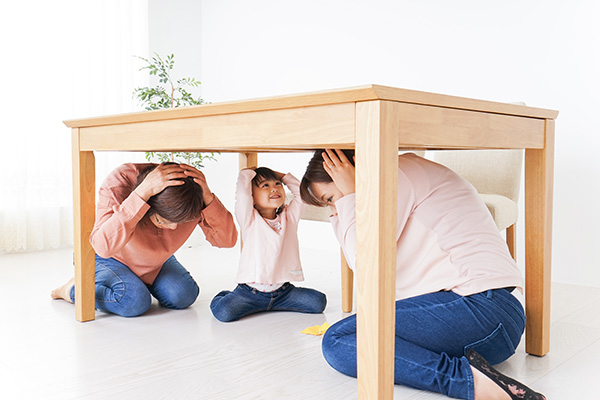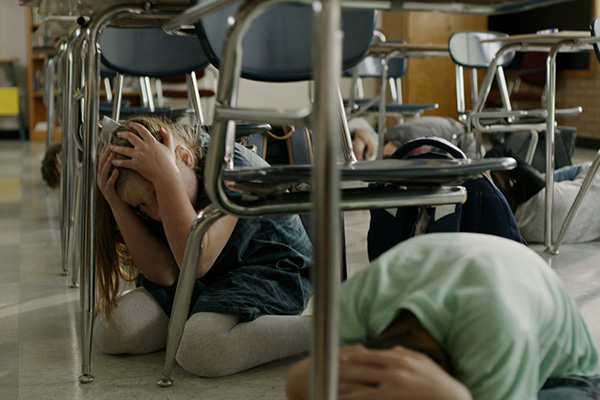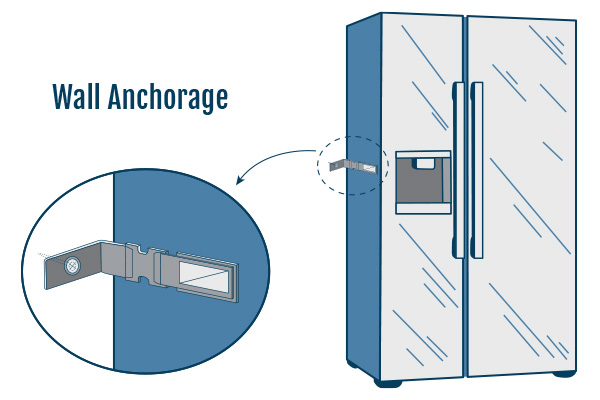For millions of people, participation in the Great California ShakeOut has become an important annual event on their fall calendars. This year, ShakeOut Day is October 20 and, at 10:20 a.m., participants once again will be reminded or will learn what to do in an earthquake drill. Everyone in California will be asked to spend 60 seconds—no matter where they are—and join millions of others to practice how to “Drop, Cover, and Hold On” if they are physically able to do so. The Great ShakeOut is supported by emergency management professionals in the U.S. and around the world. Supporters include the U.S. Geological Survey (USGS), the Federal Emergency Management Agency (FEMA) and the National Science Foundation.
What is the Great Shakeout Earthquake Drill?
California can claim credit for the very first Great ShakeOut earthquake drill. The original concept of a public, large-scale emergency preparedness event in multiple locations was launched in 2008 as the Great Southern California ShakeOut with an estimated 5.4 million participants from eight California counties.
The name eventually was changed to the Great California ShakeOut as it evolved into a statewide event conducted in-person or remotely in homes, offices, schools, and other public buildings. This year, more than 9 million Californians have registered to participate so far and 16 million have registered nationwide, according to ShakeOut organizers.
Another historical milestone occurred in 2009 when New Zealand’s Great West Coast ShakeOut was held, marking the first ShakeOut earthquake drill outside of California. Much like the Golden State, New Zealand has had more than its share of major earthquakes with devastating shakers occurring in Canterbury in 2010 and Christchurch in 2011. In 2010, the year of the Canterbury quake, New Zealand’s ShakeOut became an annual, nationwide event. Since then, other countries and more states in the U.S. have joined in making International Shakeout Day a truly global event.
The Shakeout website is an all-inconclusive, educational resource for people who use a wheelchair or a walker, and other scenarios.
Who participates in the great shakeout?
Anyone can participate! The primary purpose of ShakeOut is to prepare people in California and across the world to survive the strong shaking that can come with an earthquake. The California Earthquake Authority has multilingual ShakeOut videos on its YouTube site in English, Chinese and Spanish that show why it is important for all communities to participate in ShakeOut.
What began in one region of the Golden State has grown into an international event. ShakeOut organizers estimate that in 2021, more than 30 million people globally participated in practicing the earthquake drill procedures. This year, more than 40 million people worldwide have registered to participate, including more than 13 million school children. Here is a detailed breakdown of which states, countries and organizations will be represented this year.
How to participate in the Shakeout
The importance of practicing “Drop, Cover, and Hold On” is demonstrated in one study by the National Library of Medicine, showing that most injuries that occurred in the 1994 Northridge earthquake were the result of people falling or being hit by objects. When you consider that scientists predict there is a 99 percent chance of one or more big earthquakes happening in California sometime in the next 30 years*, participating in the Great ShakeOut should be at the top of your personal “to do” list.
ShakeOut registration is not required. However, organizers ask that those who intend to take part in the earthquake drill officially register for free because you will be among those counted in your region and you can be placed on the ShakeOut email list to receive important information on additional earthquake drill procedures that can be practiced anytime and anywhere. In addition to “Drop, Cover, and Hold On,” ShakeOut organizers provide information about many other preparedness activities.
Drop
It is important to drop in place onto your hands and knees. By being in this position, you protect yourself from being knocked down. In the drop position, you can stay low and crawl to shelter if nearby and safe to do so. It can also protect you from being hurt by flying objects.
Cover
If you are near a desk or sturdy table, crawl underneath it and cover your neck and head with your arms. If no desk or table is nearby, crawl next to an interior wall.
Hold On
Once you under a desk, table, or similar shelter, hold on to that shelter with one hand and be ready to move with your shelter if it shifts during the earthquake shaking. If there is no shelter nearby, cover your head and neck with both hands. It is important to stay in place until the shaking stops.
When is the great shakeout?
The Great ShakeOut is the third Thursday of October each year. In 2022, the Great ShakeOut is at 10:20 a.m. on October 20.
Where is the Great Shakeout
The Great ShakeOut is literally everywhere! More than 40 million people from around the world are expected to participate in the Great ShakeOut this year in-person or remotely from their homes, schools, businesses, and public facilities. No matter where you are, the basic earthquake survival practice exercise will be the same for the drill: “Drop, Cover, and Hold On."
What else can I do to prepare for an earthquake?
In addition to participating in the Great ShakeOut, there are several other measures you can take to protect yourself, your family, and your property before a major earthquake strikes. One of the most important steps to consider is strengthening your home to reduce shake damage. Learn more about the damage your home can incur during an earthquake at our blog on What Damage Can Happen to Your Home in an Earthquake.
Follow the Seven Steps to Earthquake Safety
Practicing how to “Drop, Cover, and Hold On” is an important basic step when it comes to earthquake drill procedures and preparedness. However, for those of us living in California, also known as earthquake country, there are six other equally as important steps you can take to protect yourself and your family. It is important that you familiarize yourself with the Seven Steps to Earthquake Safety.
How to protect your home
When it comes to protecting the inside of your home and its occupants, there are some relatively simple things you can do that can make a difference in an earthquake. These steps include using earthquake straps to secure water heaters and using straps and fasteners to secure appliances and heavy furniture to walls. Learn more about these measures and others you can take to improve your home’s earthquake readiness at our How to Protect Your Home from Earthquake Damage blog.
Evaluate your local earthquake risk
To better understand your individual earthquake risk and the earthquake hazards in your community, The U.S. Geological Survey website has an interactive fault map that can help you learn what faults run through your area.
Make sure your house can withstand the shaking
While no one can predict when an earthquake will pay a visit, there are proactive steps you can take to help your home better withstand shaking from the quake.
If you live in California and your home was built before 1980, it is possible your dwelling is a prime candidate for a seismic retrofit. Many of these older homes were built before modern seismic building codes were enacted, which means they often are not bolted to their foundations, and their crawl space walls may lack bracing. Without the proper bolting and bracing, these homes can slide off their foundation from the strong shaking that accompanies a major earthquake. A seismic retrofit can strengthen such homes.
Prepare for an earthquake at CRMP
As Californians, we know it is not a matter of if, but when, the next major earthquake will strike. That fact alone demonstrates the importance of both protecting our families and giving our homes a fighting chance to withstand the violent shaking that comes during a major quake.
If you own an older home built before 1980, one way to prepare for an earthquake is to seriously consider a seismic retrofit. You may even be eligible for a seismic grant through the Earthquake Brace + Bolt (EBB) program to help pay for the retrofit work. The EBB program pays up to $3,000 in retrofit grants to the owners of eligible, older homes in seismically high-risk ZIP Codes across the Golden State. And there is an additional grant for eligible, low-income residents. Registration for the 2022 grants is open October 18 through November 29.
Even if you are not eligible for an EBB grant, consider a seismic retrofit so that you are better prepared for the personal and financial repercussions that can result from a major earthquake. You can learn how to better protect your family and your home when the next major earthquake strikes by checking out our Strengthen Your House webpage.
*According to the third Uniform California Earthquake Rupture Forecast (UCERF3) report.





